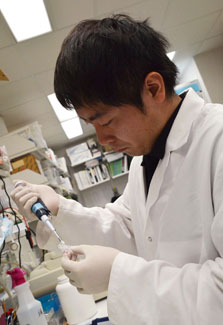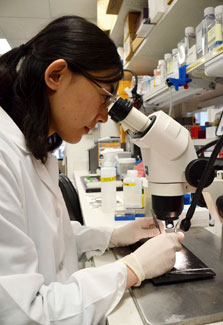Japanese fellows contribute to NIH research for more than 20 years
May / June 2016 | Volume 15, Issue 3

Photo by Karin Zeitvogel for Fogarty
The main focus of Japanese scientist
Dr. Shogo Takahashi’s work at NIH is
to study liver health in mice.
By Karin Zeitvogel
Dr. Tomoko Yamazaki peers into a microscope and dissects a tiny mouse embryo in a National Heart, Lung and Blood Institute (NHLBI) lab. Like many Japanese researchers before her, Yamazaki traveled to NIH to learn new techniques and advance her research through a two-year fellowship sponsored by the Japan Society for the Promotion of Science (JSPS). She has stayed on to complete her research into the origins of pericytes, the mural cells that envelop the surface of vascular tubes.
The results of Yamazaki’s work could be used to treat fetal vascular malformations, leakage and hemorrhage, she says. "Furthermore, if the scenario is applied to pathological pericyte development in adults, we may be able to prevent retinopathy, a symptom of diabetes where the loss of pericytes causes leakage of blood vessels," Yamazaki adds.
The young researcher’s work is an example of the "high-quality science" that nearly 300 Japanese fellows have undertaken at NIH since the program began in 1995, notes NIH’s Deputy Director for Intramural Research, Dr. Michael Gottesmann.
The fellowships are "very good for young researchers as they build their careers," says JSPS executive director, Dr. Yasuhiro Iye. Many of the researchers return to Japan after their time at NIH and become leaders in their fields, says Dr. Keiko Ozato, who recently stood down after serving for nearly 20 years as chair of the review panel that helps select JSPS fellows.
At an event celebrating the 13 young scientists who began their two-year fellowships this year, Ozato urged them to "immerse yourself in asking questions that you consider important…dedicate yourselves to science."

Photo by Karin Zeitvogel for Fogarty
Japanese visiting fellow Dr. Tomoko
Yamazaki peers into a microscope as
she dissects a mouse embryo in an
NIH lab.
One of the fellows, Dr. Tetsuro Kobayashi, is part of the team in Dr. Keisuke Nagao’s National Cancer Institute (NCI) lab that found a direct interaction between an imbalance of skin microbiota and the inflammation of atopic dermatitis in mice.
Kobayashi says working at NIH has given him an opportunity he would not have had in Japan: meeting people with diverse backgrounds and life stories. He shares lab space with two Americans, one French scientist and a German.
"You don’t see that diversity in Japan," Kobayashi says. "Japan is a very homogenous culture, which has its good points, but I think diversity is an important part of a scientist’s training. When I got to NIH, I was surprised to see that people from different backgrounds can see one phenomenon in different ways."
JSPS fellow Dr. Shogo Takahashi is working in Dr. Frank Gonzalez’s metabolism lab at NCI, studying bile acid regulator farnesoid X receptor (FXR) to try to determine how it impacts liver health in mice. In the past two years, Takahashi has co-authored several research papers on FXR, which helps to regulate the synthesis of bile acids and their transport from the liver to the intestine. Takahashi says recent studies have shown that FXR is a novel target for drugs that treat metabolic disease, such as type 2 diabetes, fatty liver disease and obesity.
Asked what he values most about his fellowship, Takahashi responds quickly: "This is NIH. You have the chance to collaborate with smart people from around the world."
JSPS not only brings young Japanese scientists to the United States to work at NIH, but also offers opportunities for U.S. and permanent resident scientists to work in Japan. Hundreds of U.S.-based researchers, including around 20 from NIH, travel to Japan each year on JSPS-supported invitational and postdoctoral research fellowships lasting from 14 days to two years.
JSPS collaborates with Fogarty and the NIH Office of Intramural Research to provide the fellowships.
More Information
To view Adobe PDF files,
download current, free accessible plug-ins from Adobe's website.